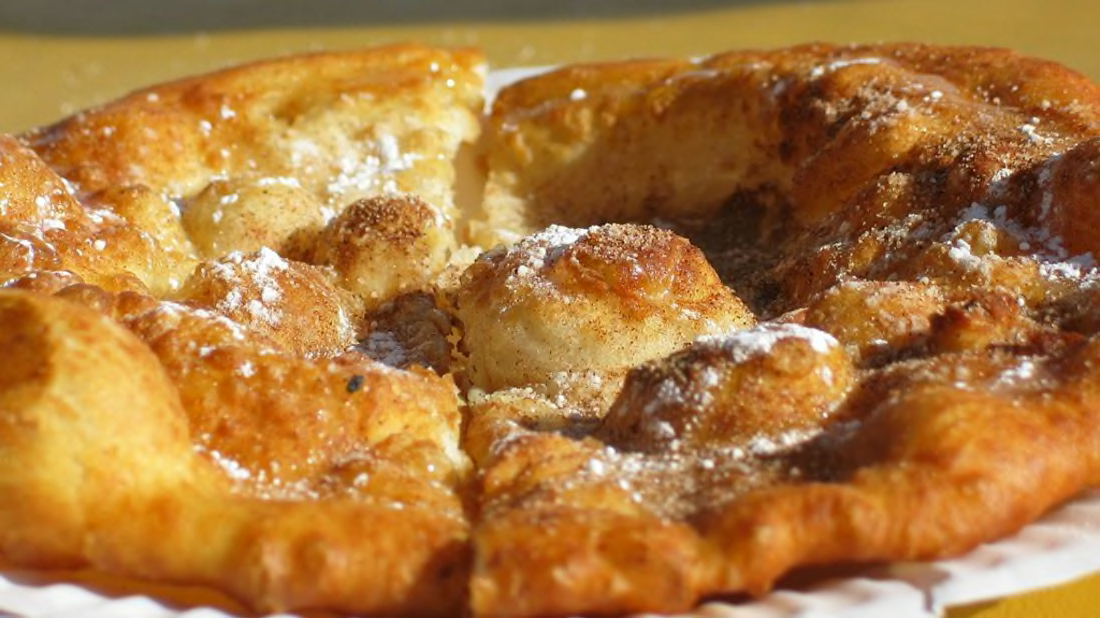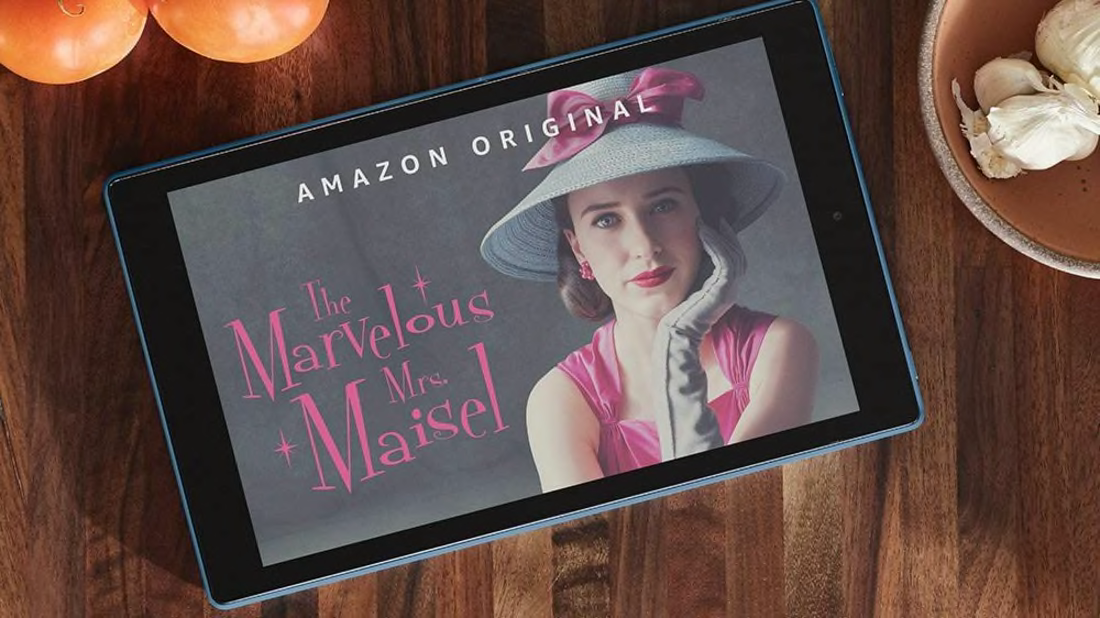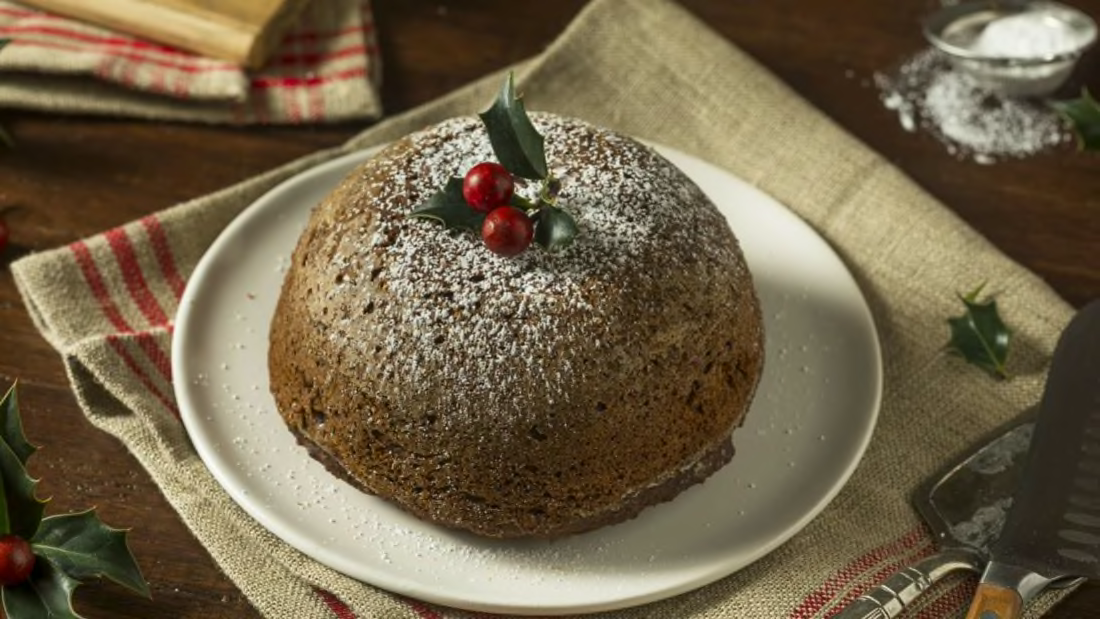
Chef Freddie Bitsoie’s earliest memory of making fry bread comes from his childhood on the Navajo Nation in Arizona. Bitsoie was still in elementary school when he and his family first made it to mark a ceremonial event. They fried the flat dough outside, placing the round in a rustic, black fry pan over an open fire until it bubbled and crisped, becoming thick yet pliable.
Fry bread contains only four ingredients—flour, baking powder, salt, and water—but behind this extraordinarily simple recipe is a complex, and tragic, history. “It’s so simple,” Bitsoie says, “but it is the most controversial Native American dish.”
Rations and Survival
Now considered a Pan-Indian food that’s nearly ubiquitous across the 574 federally recognized tribes, fry bread is not indigenous to Native American cuisine. Instead, most trace its origin story to the internment camps that arose from the forced displacement of tribes in the mid-1800s.
One such camp emerged from what would become known as the “Long Walk.” In 1864, the federal government of the United States rounded up Navajo people and forced them to march 300 miles south from their northern Arizona and Four Corners–area homelands to eastern New Mexico at Bosque Redondo. Hundreds of people died each day, and even more succumbed during their encampment.
Hundreds of miles away from familiar lands where they could forage, hunt, and grow familiar crops, the Navajo starved. The government issued them rations of flour, salt, and lard, and they cobbled together the recipe for fry bread, which helped them survive internment until an 1868 treaty allowed them to return home.
The story was a familiar one among Native American communities who experienced similar relocations and internments across the United States. Native Americans received unfamiliar foods in the relocation camps, and low-income communities continue to receive federal disbursements today [PDF]. Bitsoie, who served as executive chef at the National Museum of the American Indian until the novel coronavirus hit, says the Navajo and other tribes may have seen these ingredients being used previously. This familiarity allowed them to create the recipe for fry bread when necessity called.
Fry Bread’s Fans and Foes
Today, fry bread is most commonly eaten at ceremonial events, feast days, and powwows, intertribal fairs that include traditional dances and vendor markets. Since the federal government prohibited gatherings and expressions of indigenous identity for much of the 19th century (and beyond), powwows are often celebrated as a space to carry on heritage and express cultural pride—and it’s at those fairs where many non-Native Americans are likely to encounter the dish.
Many fairs have fry bread stands, where the bread may be topped with honey or powdered sugar, along with competitions for the best version of the dish. Pawhuska, Oklahoma, has long hosted the National Indian Taco Championship, which pits competitors against each other to make the best version of fry bread topped with typical taco toppings, such as meat, beans, lettuce, tomato, and cheese.
Some Native Americans love fry bread and claim it proudly. The slogan “Frybread Power” appears in a Superman-type crest on a T-shirt in the film Smoke Signals. Musician Keith Secola penned a song, appropriately titled “Fry Bread,” that celebrates the dish. But for others, fry bread’s association with internment has left a bad taste in their mouths.
According to Lois Ellen Frank, a Native American chef at the helm of Red Mesa Cuisine who holds a doctorate in culinary anthropology, fry bread’s history is a medley. “It’s a food that kept ancestors alive,” she says. “It’s a survival food, but it’s also one of colonization and subjugation.”
Some chefs, diners, and leaders feel the dish’s colonial past should disqualify it from dinner tables and events. In 2017, the Miss Navajo Nation contest ended the fry bread–preparation portion of the pageant and opted to have participants prepare traditional foods like blue corn mush instead.
Chef Frank is part of the movement to revitalize ancestral foods for health and wellness, which is a particular concern among a population that is plagued by obesity, diabetes, and hypertension [PDF]. A large slice of fry bread can contain 700 calories and 25 grams of fat.
Cultural Comforts
After more than 150 years, for the generations who have eaten fry bread, it can be difficult to unravel the dish’s complicated history from their cultural experience. For them, it’s risen to the level of soul food—a dish they grew up eating with friends and family that has as much nostalgia as any other of grandma’s recipes.
“There’s a huge level of comfort in it,” Bitsoie says. “Just because it wasn’t indigenous doesn’t mean it’s not part of the culture. These are family recipes, and we have a connection with it—an emotional connection, a family connection. To sever that tie by saying this isn’t traditional isn’t fair.”
A middle ground is also emerging. In her teaching and catering, Frank continues to prepare fry bread while teaching about its history—but she makes a no-fry version. She uses the same ingredients as the customary recipe but grills the bread instead of deep-frying it. It creates a healthier version while keeping an element of tradition. Denver restaurant Tocabe serves fry bread on its American Indian fast-casual menu; however, co-founders Ben Jacobs and Matt Chandra, who won the National Indian Taco Championship in 2009 with Jacobs’s family recipe, substitute a trans fat-free oil blend for the commonly used Crisco and uses a rapid flash-fry technique.
The preparations and opinions about the dish are as singular as people themselves, and Frank suggests that's the way it should be. “Every culture has a version of a fried bread,” she says. “How often and how they eat it becomes an individual decision.”

This article contains affiliate links to products selected by our editors. Mental Floss may receive a commission for purchases made through these links.
Cyber Monday has arrived, and with it comes some amazing deals. This sale is the one to watch if you are looking to get low prices on the latest Echo Dot, Fire Tablet, video games, Instant Pots, or 4K TVs. Even if you already took advantage of sales during Black Friday or Small Business Saturday, Cyber Monday still has plenty to offer, especially on Amazon. We've compiled some the best deals out there on tech, computers, and kitchen appliances so you don't have to waste your time browsing.
Computers and tablets
- Amazon Fire HD 10 Tablet 64GB; $120 (save $70)
- Amazon Fire HD 8 Tablet 64GB; $84 (save $35)
- HP Pavilion x360 14 Convertible 2-in-1 Laptop; $646 (save $114)
- HP Pavilion Desktop, 10th Gen Intel Core i3-10100 Processor; $469 (save $81)
- Acer Nitro 5 Gaming Laptop; $973 (save $177)
Headphones and speakers
- Bose QuietComfort 35 II Wireless Bluetooth Headphones; $200 (save $100)
- Sony Bluetooth Noise-Canceling Wireless Headphones; $278 (save $72)
- JBL LIVE Wireless Headphones; $100 (save $30)
- JBL Charge 4 - Waterproof Portable Bluetooth Speaker; $120 (save $10)
- Bose SoundLink Color Bluetooth Speaker II; $79 (save $50)
- Powerbeats Pro Wireless Earphones; $200 (save $50)
Video Games
- Watch Dogs Legion; $30 (save $30)
- Marvel's Avengers; $27 (save $33)
- Ghost of Tsushima; $40 (save $20)
- The Last of Us Part II; $30 (save $30)
TECH, GADGETS, AND TVS
- Amazon Fire TV Stick; $30 (save $20)
- Echo Show 8; $65 (save $65)
- Nixplay Digital Picture Frame; $115 (save $65)
- eufy Smart Doorbell; $90 (save $30)
- Samsung 75-Inch Class Crystal 4K Smart TV; $898 (save $300)
home and Kitchen
- T-fal 17-Piece Cookware Set; $124 (save $56)
- Le Creuset Enameled Cast Iron Curved Round Chef's Oven; $180 (save $136)
- Ninja Foodi 10-in-1 Convection Toaster Oven; $195 (save $105)
- Roborock E4 Robot Vacuum Cleaner; $189 (save $111)
- Instant Pot Max Pressure Cooker 9 in 1; $80 (save $120)
- Shark IZ362H Cordless Anti-Allergen Lightweight Stick Vacuum; $170 (save $110)
Sign Up Today: Get exclusive deals, product news, reviews, and more with the Mental Floss Smart Shopping newsletter!

You don't need an invitation to Sandringham House to feast like a royal this Christmas. As Town & Country reports, the royal family has published its traditional figgy pudding recipe, so anyone can whip up a holiday dish fit for the Queen at home.
The royal family's official Instagram account shared the recipe on November 29, which is also known as Stir-up Sunday. Traditionally, the Sunday before the start of the Advent season is when home cooks in Britain stir up the pudding mixture they plan to serve on Christmas.
"This year, chefs in the Royal kitchens have shared their recipe for a traditional Christmas pudding," the post reads. "We hope that some of you enjoy making it in your own homes."
The recipe calls for raisins, currants, sultanas, citrus peel, suet, breadcrumbs, flour, and spices. After mixing the dry ingredients together, add eggs and alcohol and transfer the mixture to a bowl to steam it. The pudding can be prepared ahead of time and reheated on Christmas Day. The full recipe, plus a video with step-by-step instructions, is included in the Instagram post below.
Figgy pudding, or plum pudding, doesn't necessarily contain plums or figs. The classic British dish can be made with practically any type of dried fruit. And unlike American pudding, it's more cake-like than custard-like.
This isn't the first time the royal kitchen has revealed its secrets to the public. Earlier this year, former royal chef Darren McGrady shared his recipe for the chocolate biscuit cake that's enjoyed by the Queen.
[h/t Town & Country]
"bread" - Google News
December 01, 2020 at 01:35AM
https://ift.tt/36nWysE
Fry Bread's Controversial History - Mental Floss
"bread" - Google News
https://ift.tt/2pGzbrj
https://ift.tt/2Wle22m
Bagikan Berita Ini














0 Response to "Fry Bread's Controversial History - Mental Floss"
Post a Comment